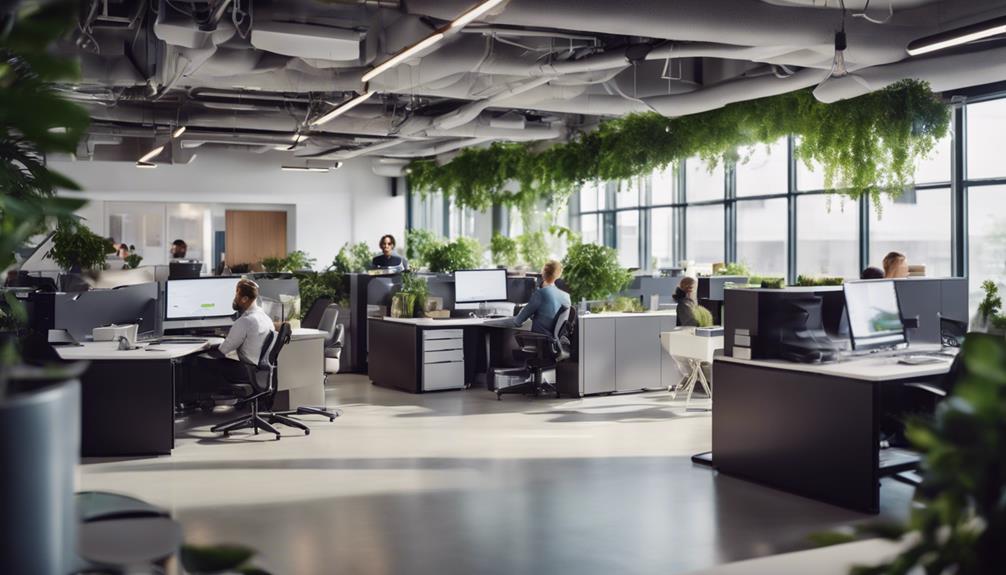Transforming the commercial real estate industry involves embracing flexibility and prioritizing tenant needs. There is a noticeable shift from traditional long-term leases to more adaptable arrangements that cater to a wide range of businesses. Visionary leaders like Lawrence Gellerstedt at Southsource Advisors emphasize the importance of cultivating lasting relationships. Collaboration and creativity in workspace design are crucial, while trends like Furniture-as-a-Service (FaaS) promote sustainability and cost-effectiveness. As the industry continues to evolve, focusing on tenant satisfaction will be key to staying ahead. Let’s delve into the essential insights that can shape your success strategy in this ever-changing landscape. Revolutionizing the future with FaaS not only entails providing furniture, but also delivering a comprehensive package of services that enhance a seamless and efficient workspace experience. This approach enables businesses to adapt and grow without being constrained by expensive and rigid leases. By embracing this shift towards flexibility and tenant-centered design, commercial real estate professionals can establish themselves as industry leaders and drive long-term success. Revolutionizing the future with FaaS
Key Takeaways
- The rise of flexible leasing models is reshaping commercial real estate, prioritizing tenant adaptability over long-term commitments.
- Community-oriented workspaces are becoming essential, enhancing collaboration and tenant satisfaction in response to evolving needs.
- Sustainable building practices and eco-friendly designs are increasingly important, reflecting a commitment to environmental responsibility in real estate.
- Embracing technology, such as smart buildings, enhances tenant experiences and streamlines operations within commercial spaces.
Career Path of Lawrence Gellerstedt

Lawrence Gellerstedt's career path in commercial real estate is marked by pivotal changes, including his move from Cushman & Wakefield to WeWork and eventually founding Southsource Advisors in 2020.
At Atlanta Tech Village, you can see how he honed his skills in office leasing, focusing on the unique needs of tech firms. He emphasizes understanding client objectives to foster strategic growth.
Gellerstedt prioritizes authenticity, building long-term relationships with companies like SalesLoft, Terminus, and Calendly.
At Southsource, you'll find him overseeing brokerage activities and tech investments, delivering personalized services that adapt to client needs.
His commitment to innovation and flexibility guarantees that he's always aligned with the evolving landscape of commercial real estate.
Shifts in Commercial Real Estate
The commercial real estate landscape is rapidly evolving, driven by shifts toward flexible leasing models and an increasing focus on tenant experience and satisfaction.
You're likely noticing a move away from traditional long-term leases, as businesses seek more adaptable arrangements. This change allows you to respond quickly to market demands and adjust your space as needed.
Creative workspaces and community-oriented projects are becoming more prevalent, emphasizing collaboration and innovation.
As a landlord, adapting to these trends is essential for maintaining a competitive edge. By prioritizing tenant needs and experiences, you can cultivate lasting relationships and guarantee your properties align with the future of work.
Embrace these shifts to thrive in an ever-changing commercial real estate environment.
Lessons From Wework Experience

WeWork's journey offers valuable lessons in flexibility and collaboration that can shape the future of commercial real estate.
You'll see how embracing diversity within teams can drive innovative solutions, as WeWork's model highlighted the clash between tech and real estate perspectives. It's vital to foster a culture where all voices contribute to decision-making.
Additionally, the focus on flexible leasing arrangements can meet evolving tenant needs, promoting long-term relationships.
Adapting quickly in response to challenges is significant; lessons from WeWork's leadership struggles underscore the importance of clear identity and mission.
Growth of Flexible Leasing Models
Flexible leasing models are rapidly gaining traction in commercial real estate, driven by shifting tenant demands for adaptability and shorter commitments.
You'll find that businesses today prioritize flexibility over long-term obligations, which allows them to scale operations quickly without being locked into traditional leases.
This shift encourages landlords to rethink their strategies, offering more dynamic lease structures that cater to evolving needs.
By implementing flexible leases, you can attract a diverse range of tenants, from startups to established firms looking for agility.
As the market continues to change, embracing these models won't only enhance tenant satisfaction but also position you ahead of competitors who stick to outdated leasing practices.
Flexibility is now the key to thriving in this new landscape.
Impact of Furniture-as-a-Service

Furniture-as-a-Service (FaaS) increasingly transforms how businesses approach workspace design and management, offering adaptable solutions that meet evolving tenant needs.
You'll find that this model allows you to rent furniture instead of purchasing it, reducing upfront costs while providing flexibility. With FaaS, you can quickly adjust your workspace to accommodate changes in team size or function, enhancing productivity and collaboration.
It promotes sustainable practices by encouraging rental over ownership, minimizing waste. As a result, you're not only optimizing your office environment but also supporting eco-friendly initiatives.
This shift towards FaaS reflects a broader trend in commercial real estate, where adaptability and cost-effectiveness are essential for attracting and retaining tenants in a competitive market.
Workplace Design Evolution
The shift towards adaptable workspace solutions is reshaping how businesses approach workplace design, prioritizing flexibility and collaboration to meet the evolving demands of the modern workforce. You'll find that today's spaces are no longer just about desks and chairs; they're about creating environments that foster innovation and enhance employee satisfaction.
| Feature | Benefits | Trends |
|---|---|---|
| Flexibility | Adapts to changing needs | Short-term leasing |
| Collaboration | Encourages teamwork | Creative workspaces |
| Sustainability | Reduces environmental impact | Eco-friendly designs |
Importance of Collaboration

Collaboration is essential in commercial real estate, driving innovation and fostering strong relationships that can lead to successful outcomes for everyone involved.
When you work together with diverse stakeholders, you tap into a wealth of perspectives and expertise that can enhance decision-making. By sharing knowledge and resources, you can tackle complex challenges more effectively and create solutions that benefit all parties.
Building trust through open communication and shared goals is crucial, as it helps you navigate market shifts and evolving tenant demands.
Emphasizing collaboration also encourages a culture of creativity, allowing you to explore new ideas and adapt swiftly to changes.
Ultimately, strong partnerships can elevate your business, improve tenant experiences, and contribute to a more resilient industry.
Future Trends in Real Estate
As you explore the evolving landscape of commercial real estate, you'll find that future trends are increasingly shaped by sustainability, technology integration, and the rise of hybrid work models. Here are five key trends to watch:
- Sustainable Building Practices: Expect more eco-friendly designs and materials.
- Tech-Driven Solutions: Smart buildings will enhance tenant experience through automation.
- Flexible Leasing Options: Short-term leases will become the norm as businesses adapt.
- Community-Centric Spaces: Workspaces will focus on collaboration and tenant satisfaction.
These trends reflect a shift toward a more dynamic, responsive real estate market, helping you stay relevant and competitive in this fast-changing environment.
Conclusion
As you sail through the sea of commercial real estate, remember that adaptability is your compass. Just like a skilled captain navigates shifting tides, you'll thrive by embracing flexible leasing models and innovative designs.
The winds of collaboration and authenticity will guide your journey, leading you to uncharted waters of opportunity. Keep your crew diverse and your vision clear, and you'll discover that the horizon holds endless possibilities for growth and transformation in this vibrant industry.









